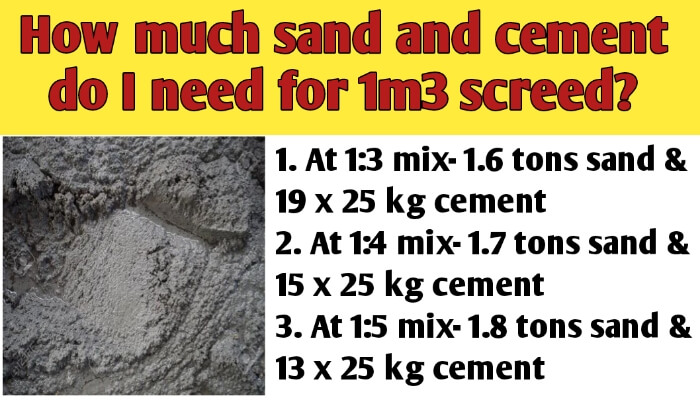The amount of sand and cement required for 1 m3 of screed depends on the mixing ratio of sand and cement. In general, with a mixing ratio of 1:4 (cement and sand), you need around 1.7 tons of sand and 15 bags of 25 kg of cement to produce one cubic meter of screed.

The screed are used to levelling imperfect floors or uneven surface. It is used to cover structural flooring concrete, and can be applied to either a solid, in-situ or precast concrete floor slab. It will produce a smooth and hard underlayment which is suitable for laying tiles, to cover concrete structure, carpets and wooden flooring.
The mix ratio for screed can range from 1:3 to 1:5 (cement to sand) depending on the desired consistency, workability and other factors. However, the standard screed mix ratio is 1:4 cement to sand, creating a soft, malleable texture that is easy to work with.
To calculate the amount of sand and cement required for 1 cubic meter (1m³) of screed, you typically use a mix ratio. The most common mix ratio for screed is 1:4 (cement to sand). Bulk density of cement is 1,440 kg/m³ and bulk density of sand is 1,600 kg/m³, now, you can calculate the weight of cement and sand by = Volume x Bulk density.
Here’s how you can calculate quantity of sand and cement for 1 m3 of screed at 1:4 mix:
- Calculate dry volume of screed: Dry volume of screed = Wet volume × 1.33 = 1m3 × 1.33 = 1.33 m3, means to prepare 1m3 of screed you may need 1.33 m3 of dry ingradients of sand and cement.
- Determine proportion of sand and cement: Since the mix ratio is 1 part cement to 4 parts sand, so total proportion = 1 + 4 = 5, thus parts of cement = 1/5 and parts of sand = 4/5
- Determine the quantity of cement: Volume of cement = 1/5 × 1.33 = 0.266 m3, cement quantity in kg = 0.266 × 1440 = 383 kg, cement quantity in bags = 383/25 = approx 15 bags.
- Determine the quantity of sand: Volume of sand = 4/5 × 1.33 = 1.064 m3, sand quantity in kg = 1.064 × 1600 = approx 1,700 kg, sand quantity in bags = 1,700/25 = approx 68 25kg bags (or 1.7 tonnes).
Typically, 1700 kilograms of sand (approx. 1.7 tons) and 15 x 25 kg of cement with the recommended mixture of 1:4 (cement and sand) are required to produce 1 m3 of screed.
Here’s how you can calculate quantity of sand and cement for 1 m3 of screed at 1:3 mix:
- Determine proportion of sand and cement: Since the mix ratio is 1 part cement to 3 parts sand, so total proportion = 1 + 3 = 4, thus parts of cement = 1/4 and parts of sand = 3/4
- Determine the quantity of cement: Volume of cement = 1/4 × 1.33 = 0.3325 m3, cement quantity in kg = 0.3325 × 1440 = 480 kg, cement quantity in bags = 480/25 = approx 19 bags.
- Determine the quantity of sand: Volume of sand = 3/4 × 1.33 = 1 m3, sand quantity in kg = 1 × 1600 = 1,600 kg, sand quantity in bags = 1,600/25 = approx 64 bags (or 1.6 tonnes).
Typically, 1600 kilograms of sand (approx. 1.6 tons) and 19 x 25 kg of cement with the recommended mixture of 1:3 (cement and sand) are required to produce 1 m3 of screed.
Here’s how you can calculate quantity of sand and cement for 1 m3 of screed at 1:5 mix:
- Determine proportion of sand and cement: Since the mix ratio is 1 part cement to 5 parts sand, so total proportion = 1 + 5 = 6, thus parts of cement = 1/6 and parts of sand = 5/6
- Determine the quantity of cement: Volume of cement = 1/6 × 1.33 = 0.22 m3, cement quantity in kg = 0.22 × 1440 = 320 kg, cement quantity in bags = 320/25 = approx 13 bags.
- Determine the quantity of sand: Volume of sand = 5/6 × 1.33 = 1.108 m3, sand quantity in kg = 1.108 × 1600 = 1,775 kg, sand quantity in bags = 1,775/25 = approx 71 bags (or 1.8 tonnes).
Typically, 1,775 kilograms of sand (approx. 1.8 tons) and 13 x 25 kg of cement with the recommended mixture of 1:5 (cement and sand) are required to produce 1 m3 of screed.
Conclusions:
Typically for 1 cubic meter of screed with a mix ratio of 1:3 (cement to sand), you’ll need approximately 480 kg of cement and 1,600 kg (or 1.6 tonnes) of sand.